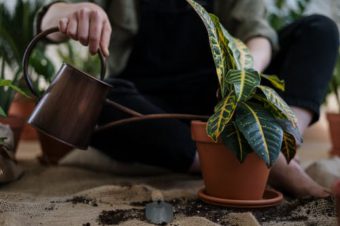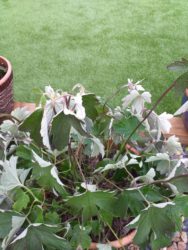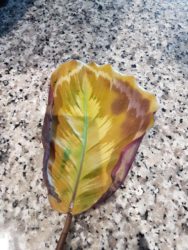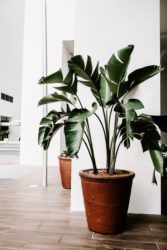In this article, we will be discussing the right way to water your houseplants. Often houseplants enthusiasts get their watering wrong, either given too much or too little and as a result, the plant suffers.

In this article, we will discover what houseplants look like with too little water and what houseplants that get too much water look like. We will also discuss when to water, but this is so dependent on the plant in question and finally what the best watering regime to use for houseplants.
We all know that water is essential for all life and plants are no different. Plants need an adequate supply of water for plant‘s health, otherwise wilting can occur, as this is the first sign a plant lacks water.
Many people in this situation would think naturally that the plant is short of water and therefore water the plant yet again. Surprisingly plants can wilt if the roots are waterlogged in the growing media, Consequently, the application of more water can make the condition worse. So, if you see a plant wilting your first-course of action is to make sure the compost is dry before taking any remedial action.
TOO LITTLE WATER AT THE ROOTS
Most modern houseplant compost tends to shrink as they dry out and they become very light in weight. The first sign a plant needs water is to see if the compost has shrunk away from the sides of the pot. If watering has not been done for a while the pot weight will decrease.

Both of these observations indicate extreme dryness of the compost, which is not easily remedied by watering from the top.
If this occurs the best way of dealing with this situation is to immerse the pot in water to just below the level of the compost in the container and leave it there until the surface of the compost begins to darken. This could take a while depending on the size of the container.
If the pot is less dry, it is best to check it by pushing your finger in the compost and if 5cm below the surface feels dry then the plant needs to be watered. When you water add it from the top and stop when water emerges from the drainage hole. Any water that collects on a saucer should immediately be disposed of, preventing the compost from becoming waterlogged.
Often people when they water they do it lightly. They fail to water the compost adequately; they water frequently but the water does not penetrate more than the first few cms. This only wets the top layer of the compost and does not penetrate deeper into the pot. The result is that the roots do not get enough water.
TOO MUCH WATER
Too frequent and heavy watering can lead the compost to become compacted, become waterlogged and to become soggy. This can have a lethal effect on plants since the vital supply of oxygen to the roots has been cut off. The roots stop growing and can no longer supply the top parts with sufficient water, causing the plant to wilt.

The problem is waterlogging also favours various root rots, be it fungal or bacterial, unless the situation is quickly remedied. The roots will turn black and the plants die. If the pot feels very heavy then it is a clear indication that the houseplant has been waterlogged.
The damaged caused can be examined by knocking the plant out of the pot and checking on the condition of the compost and the state of the roots. The solution is to repot the plant in fresh compost, making sure that all old material is removed from the roots and the roots have been thoroughly washed. Any black or damaged roots must be cut off and the plant placed in new compost suitable for the plant in question.
WHEN TO WATER
Watering should become a habit but not a habit did to a fixed schedule. This is because each type of plant has its own requirements, varying according to the relative size of the plant, the pot type and also the growing conditions.
This type of pot affects the frequency of watering since ceramic pots lose water more rapidly than do plastic pots. One constant rule is that all plants require less water in winter.
The only proven way to see if a plant needs watering is to use a moisture meter inside the plant pot to determine the state of the compost. First, look to see if the surface has dried out and then use a moisture meter or carry out the finger test to check the state if the upper layer of the compost.
If the finger stays dry when pushed into the compost, the plant needs to be watered. If it does not feel wet, do not water.
WATERING REGIMENS FOR HOUSEPLANTS

Each type of houseplant has its special requirements for water but saying that they can be split into three main groups:
DRY IN WINTER- Cacti and succulents need to be kept short of water during the winter months and the compost can be left almost completely dry. In spring and summer, however, they should be treated as moist/dry plants (see the next group).
MOIST/DRY- Most foliage and flowering plants fall into this group. For these plants throughout the spring and summer, they need a generous watering each time the top layer of compost has dried out. Less frequent and light watering if needed in winter. In between waterings, some drying out of the compost is desired, since it ensures that there is adequate aeration of the roots.
MOIST AT ALL TIMES- Only a few plants flourish if the compost is kept constantly wet. This includes plants like Acorus and Cyperus benefit by having the base of the pot standing in water. Azaleas that are usually potted in free-draining compost also falls into this group.
HOW TO WATER HOUSEPLANTS
The easiest and most convenient method is to use a small watering can with a long watering spout to apply the water to the top of the compost, whilst avoid wetting the leaves. Filing the pot to the top gives adequate watering needs for the summer months. In winter, apply the water more cautiously and sparingly to avoid getting the compost waterlogged.
THERE ARE EXCEPTIONS
The above method is unsuitable for water African violets since the velvety leaves can be damaged by water droplets, as it can be difficult to insert the watering can spout under the tightly packed leaves. Tuberous plants such as gloxinias and cyclamens also need special treatment since their crowns can become diseased if they get wet.

The best way of watering these plants is to immerse the pots in bowls of water to just below the top of the compost, leaving them there until the surface of the compost darkens. The pots should then be allowed to drain before they are placed back to their rightful position.
Bromeliads also need special treatment, since in addition to normal watering of the compost, the central core of leaves, often called the ‘Vase’ or ‘Urn’ needs to be kept full of water. This vase needs to be empty and replenished every couple of months. If possible use rainwater as in some areas hard tap water can leave unsightly residue on the leaves.
CONCLUSIONS
In this article, we have discussed the importance of getting the watering of your houseplants right. As you can see it is not an easy task to get it just right. It is easy to overwater as much as it is to underwater. Plants, in general, have a small window where they are happy, too little and the plant wilts, too much and the plant can suffer from root rots.
You now have a better idea of how to water, when to water and what watering regime to follow. As I say it is better to water the plant in the pot when it needs it and not to do it routinely.
If you have any questions or comments that you wish to make, please do so in the comment box below.
Do not allow your houseplants to drown or to dry to excess.

Thank you for this helpful post. I think I have killed so many plants in my life due to overwatering. I prefer indoor plants that have a watering system from the bottom, then you can see when they need water.
I love the tips you share like the soil shrinking away from the side of the pot when it is dry, but I suppose this is a bit too late to water again. I think I am going to get a water meter as suggested, and hopefully, this gadget will solve my problem.
Hi Michel
It is often a very difficult task to get the watering of houseplants right. They sulk if they are underwatered and the yellow if you overwater. You have a small window to water in and you must get it right.
Thank you for visiting once again.
Antonio
Wow, I didn’t even think that I have been watering my plants very incorrectly. Seems like there are different ways to water different plants too. I have to say that this is very good and I am happy to be able to learn what you have written here. I am most definitely going to have to try this in my watering too. Thanks.
Hi Jay
It is important that you get the watering of houseplants right, otherwise, you will have sad looking plants, which you do not want at all costs. I have gone into the right way in great depth, so you can get to know the techniques that will actually work.
Thank you for your comment.
Antonio
Thank you for this article! It is always too hard for me to take care of my plants the right way – but I don’t want to give up, I think that with the right tips I can do better! So, I landed on your article and I realized many things – for example, that a ‘yellow’ leaf means overwatering (I have to admit that it is always difficult to understand the right watering according to the plant). Thank you!
Hi rosalia
You have hit the nail on the head, as often people will hardly water their houseplant or they go onto the opposite extremes and give the plant too much water. I have tried to address this issue so that people know how much water to give their plants. I hope you apply it to your collection.
Thanks for commenting
Antonio